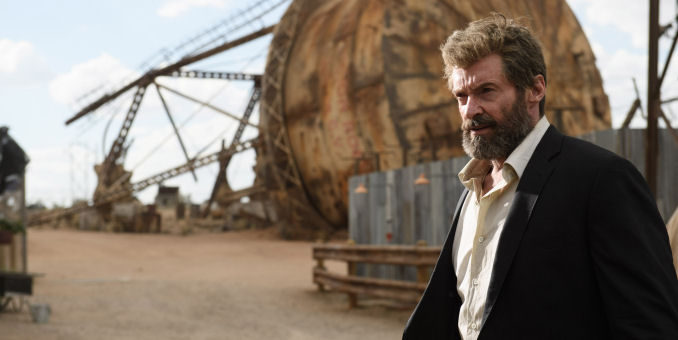
 It’s 2029 and things are tough for Logan (Hugh Jackman). All mutants are dead except for him, Professor Xavier (Patrick Stewart), who is suffering from an Alzheimer’s-like degenerative brain disease, and Caliban (Stephen Merchant), an albino mutant with the power to find other mutants who acts as the pair’s housekeeper. Logan is working as a limo driver in El Paso, trying to earn enough for a yacht so he and Charles can live at sea. His healing power doesn’t work the way it used to–what once took moments to heal now take days–and that is a bad thing when you have adamantium on your bones.
It’s 2029 and things are tough for Logan (Hugh Jackman). All mutants are dead except for him, Professor Xavier (Patrick Stewart), who is suffering from an Alzheimer’s-like degenerative brain disease, and Caliban (Stephen Merchant), an albino mutant with the power to find other mutants who acts as the pair’s housekeeper. Logan is working as a limo driver in El Paso, trying to earn enough for a yacht so he and Charles can live at sea. His healing power doesn’t work the way it used to–what once took moments to heal now take days–and that is a bad thing when you have adamantium on your bones.
Logan has left the heroing world behind. Which is bad news for Gabriela (Elizabeth Rodriguez) and Laura (Dafne Keen), who are looking for Logan’s help to get away from some bad men. Refuse as strong as he might, Logan finds himself drawn into helping the ladies anyway, in the process finding a connection with Laura that he did not expect and he cannot deny.
Logan is for all intents and purposes a chase film. The deadliest flaw a chase film can have is to drag. And Logan drags. A lot. So much so its other flaws are laid bare for the world to see.
James Mangold, directing a story he wrote that was adapted into a screenplay he co-wrote with Michael Green and Scott Frank, seems to believe this time around that moving at a languorous pace adds weight to the film. Granted, a certain amount of time is needed to set up the future reality the characters are living in, but do we really need a montage to show us how much Logan’s job as a limo driver sucks? No, we don’t, and the fact that he sneaks in some naked breasts during the montage doesn’t change that fact.
 Then there’s the farmhouse scene in the middle of the film that is especially annoying. It’s there to reinforce the themes of showing Logan the family he lacks and that anybody who gets close to him typically dies horribly. But it goes on way too long and only comes about by making the main characters act like morons (The bad guys are after us, have already caught up to us after we stopped once, but let’s stop again! Durr!).
Then there’s the farmhouse scene in the middle of the film that is especially annoying. It’s there to reinforce the themes of showing Logan the family he lacks and that anybody who gets close to him typically dies horribly. But it goes on way too long and only comes about by making the main characters act like morons (The bad guys are after us, have already caught up to us after we stopped once, but let’s stop again! Durr!).
However, like I felt with Batman vs. Superman: Dawn of Justice, Logan was another case of being too long yet not long enough. While what we got would have benefited from a stronger editor or a less indulgent writer, there were a lot of elements of the plot that should have been explored more. For instance, how did Caliban join up with Logan and Xavier? Also, what actually happened to the X-Men? Both of these points could have been meaty scenes in the film. We only get a few lines of dialogue thrown at them.
 All of this makes you be less willing to overlook glaring plot contrivances that you would of over looked in another film. Like Gabriella being able to make a well edited video for Logan with killers on her trail. Or Xavier’s illness coming and going as the plot required it. Or Laura knowing how to drive a car. Or the adamantium bullet. Or the healing power boosting serum. And so on.
All of this makes you be less willing to overlook glaring plot contrivances that you would of over looked in another film. Like Gabriella being able to make a well edited video for Logan with killers on her trail. Or Xavier’s illness coming and going as the plot required it. Or Laura knowing how to drive a car. Or the adamantium bullet. Or the healing power boosting serum. And so on.
This is a shame because it could have been a great film. The themes of family and belonging are powerful ones. The actions scenes are brutal, exciting and make full use of the film’s R-rating. The acting is top notch from the top down, starting with the typical great performances from Stewart and Jackman, to Merchant and Richard E. Grant as Dr. Rice–both who make the most of what’s given to them, to Boyd Holbrook who is one of the most charismatic villains you’ve ever seen in comic book films. Like Rich, I have to single out Dafne Keen’s performance as Laura for special praise. A relative newcomer (this film was only her second project), she had the most difficult part in the whole film and exceeded any expectations. I would say that with the right roles, Keen could have a Jodie Foster-esque career ahead of her. She’s that good here.
Which makes the film even more of a disappointment. All the elements of a proper send-off for Jackman were here. But Mangold fumbled it through cutting corners and botched pacing. Logan deserved better.



